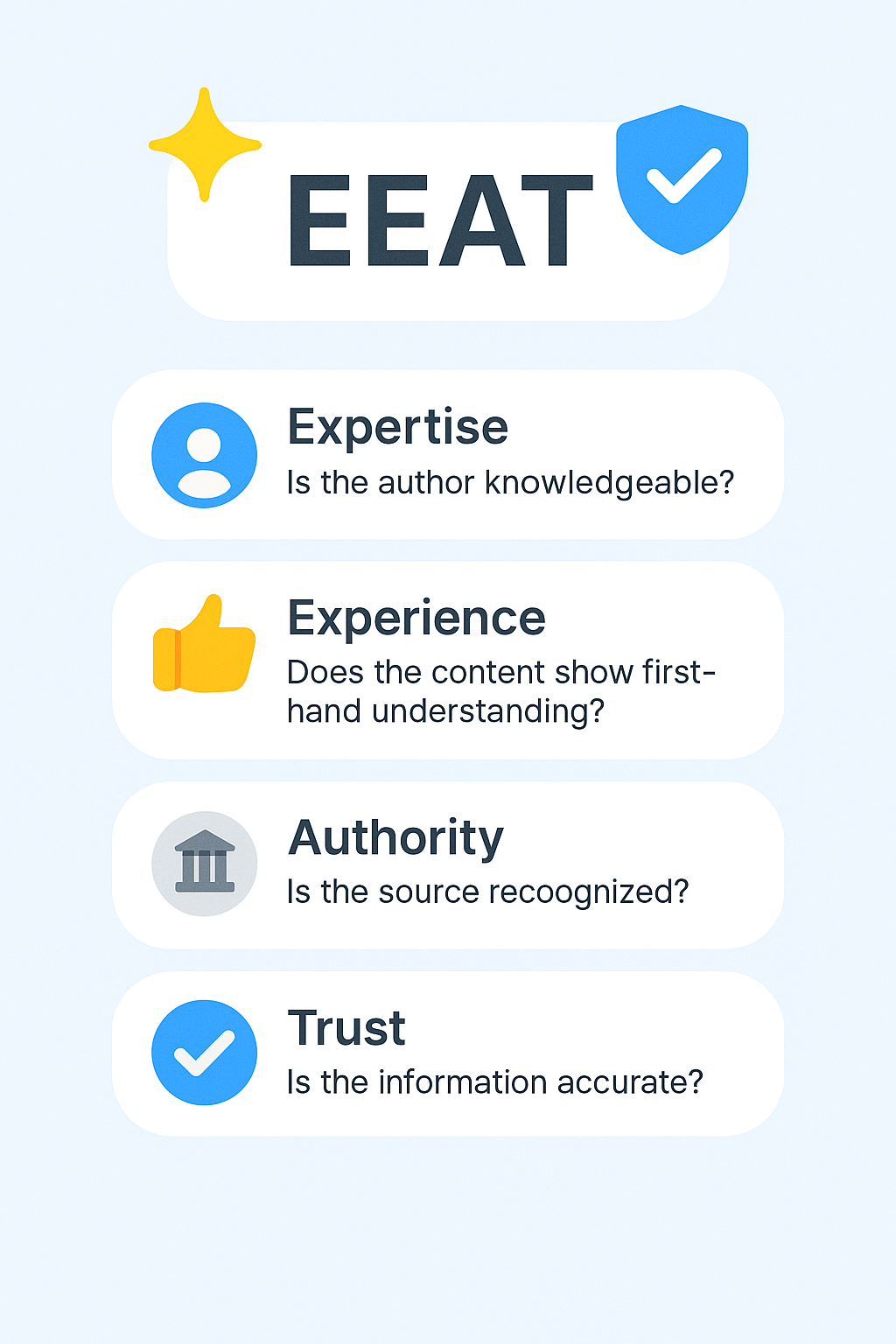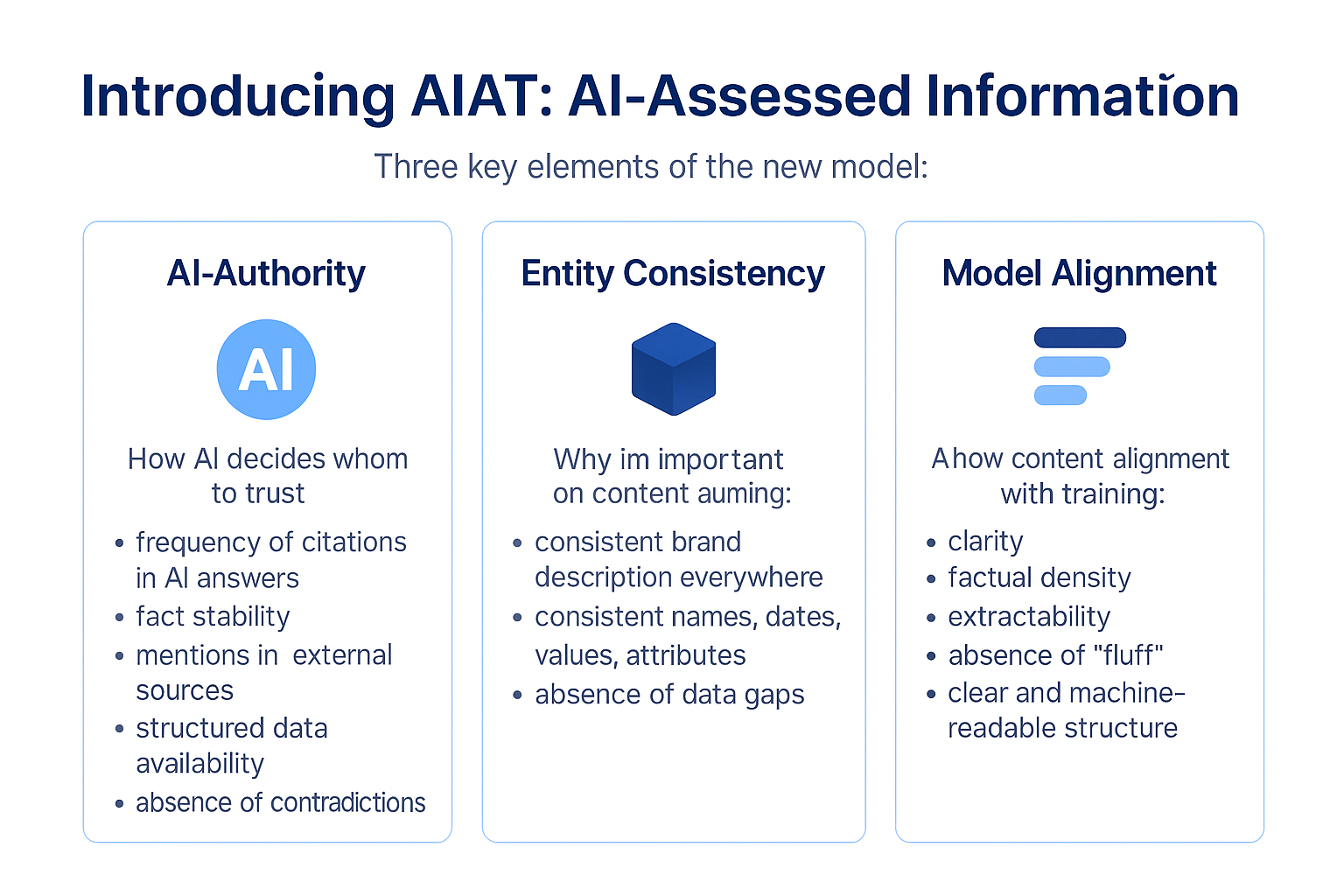November 21, 2025
Semantic Blocks: The New Structure of AI-Optimized Content
November 20, 2025
Multimodal SEO: How AI Uses Images, Video & Diagrams to Rank Pages
November 18, 2025
Author:
.png)
EEAT has been one of Google’s core quality frameworks since 2018. It helped search engines distinguish trustworthy content from noise by evaluating a page’s Expertise, Experience, Authority, and Trustworthiness.
For years, this system worked well because Google controlled the search ecosystem — the classic blue-link SERP.
But 2025 changed the rules.
AI search engines like SearchGPT, Perplexity, and Bing Copilot no longer just “rank pages” — they interpret information, make recommendations, and choose which brands to cite inside their answers. This shift means that trust is no longer evaluated only by Google’s algorithms.
“In 2025, trust is not only rated by Google — it’s rated by AI models themselves.”
Large language models assess data consistency, factual stability, entity clarity, reputation patterns, and cross-web alignment in ways traditional SEO frameworks never covered.
That’s why EEAT is evolving into AIAT — AI-Assessed Information Trust, a broader model that reflects how AI systems understand expertise, authority, and reliability across the entire web — not just on a single page.
EEAT was created to help Google evaluate page quality at a time when ranking happened inside a linear list of links. Its components:
These signals were perfect for the classic SERP era. Google’s crawlers could analyze on-page elements, backlinks, and author signals to decide which pages deserved top positions.
For nearly a decade, this framework helped filter out thin content, content farms, and low-trust sites.
But EEAT was designed for a world where:
Now, with AI answer engines synthesizing information from entities, datasets, media, and cross-web signals, EEAT alone can’t capture the full picture.

AI search engines no longer display a list of 10 blue links — they interpret, summarize, and select only the sources they trust.
This changes everything.
Instead of evaluating an individual page, modern LLMs (SearchGPT, Perplexity, Bing Copilot) evaluate the entire entity behind the content: its history, reputation, consistency, sentiment, and factual stability across the web.
This means traditional EEAT signals now represent only half of what determines trust.
AI models go beyond on-page EEAT by analyzing:
Unlike Google’s URL-level ranking, LLMs evaluate the coherence and reliability of the entire information cloud surrounding your brand.
This is why EEAT alone can’t satisfy AI search engines — they require deeper, machine-readable trust signals.
AIAT is the evolution of EEAT — a framework that reflects how AI models (not just Google) evaluate trustworthiness, authority, and factual reliability.
AIAT consists of three new pillars:
How AI decides which sources deserve to appear in its answers.
AI measures authority differently from Google.
AI doesn’t “trust” an author bio — it trusts consistent, verifiable, aligned information.
AI models build an entity embedding for every brand, person, or product.
If your data is inconsistent, the embedding becomes noisy — and AI models avoid citing you.
A clean, stable entity = higher trust and more AI visibility.
AI prefers content that matches how the model was trained to understand and extract information.
In short:
humans read paragraphs — AI reads structure.
Model alignment is now an expertise signal on its own.
This new model explains why some brands dominate AI answers while others disappear — even if both follow classical EEAT.

Optimizing for AIAT means moving beyond traditional page-level signals and building machine-readable trust across your entire digital ecosystem. AI does not “read” content the way humans do — it analyzes patterns, consistency, structure, and interconnectedness.
Here’s how to align with that:
Add and maintain Schema.org types (Organization, Person, Product, FAQ, Article).
AI relies heavily on structured fields to form accurate entity embeddings.
LLMs prioritize sources with clear, stable, tabular data they can cross-reference.
Specs tables, pricing tables, documentation datasets — all boost AI trust.
AI models extract and compare facts. Clean, unambiguous definitions help prevent hallucination and increase your likelihood of being cited.
SearchGPT and Perplexity give preference to recently updated sources.
Automatic freshness updates (dates, versioning, changelogs) improve visibility.
AIAT values global consistency: your brand descriptions, features, pricing, messaging must match everywhere.
Misaligned data → noisy entity → lower AI trust.
LLMs love:
The easier your content is to parse, the more likely it is to be included in an AI answer.
Here’s how the old system and the new system differ in scope and evaluation:

This table makes it clear: EEAT is about your page. AIAT is about your entire information ecosystem.
Google is already moving toward an AI-first quality model.
Several shifts are happening:
Instead of judging content per URL, Google increasingly evaluates brands as entities, similar to how LLMs do.
Conflicting data across platforms will negatively impact trust.
Google will prioritize sources with stable, cross-verified facts.
AIO pulls data from:
EEAT alone can’t secure visibility inside AIO — you need global consistency and structured clarity.
Google wants to avoid hallucinations inside AIO.
Therefore, it will heavily favor brands with:
AIAT fits perfectly into this new model.
The next 2–3 years will redefine how trust is measured online.
Each model (OpenAI, Google, Anthropic) will form its own view of your entity, independent from Google’s signals.
Messy data = low AI-authority → no citations → no visibility.
Not just content — but:
This is the new “SEO”.
This is the formula for AIAT.
“In the AI era, trust is not what you say — it’s the consistency of every trace of data about you.”
Your new AI assistant will handle monitoring, audits, and reports. Free up your team for strategy, not for manually digging through GA4 and GSC. Let us show you how to give your specialists 10+ hours back every week.
Read More

November 21, 2025
10 min

November 20, 2025
10 min

November 18, 2025
10 min
Just write your commands, and AI agents will do the work for you.